Female indie artists play a vital role in reshaping the music industry through innovation and authentic storytelling. They face challenges such as gender bias and financial instability while navigating cultural differences. Despite these obstacles, many have achieved notable success, exemplified by artists like Billie Eilish and Phoebe Bridgers. Collaborations and effective use of social media are key strategies that enhance their visibility and engagement in a competitive landscape.
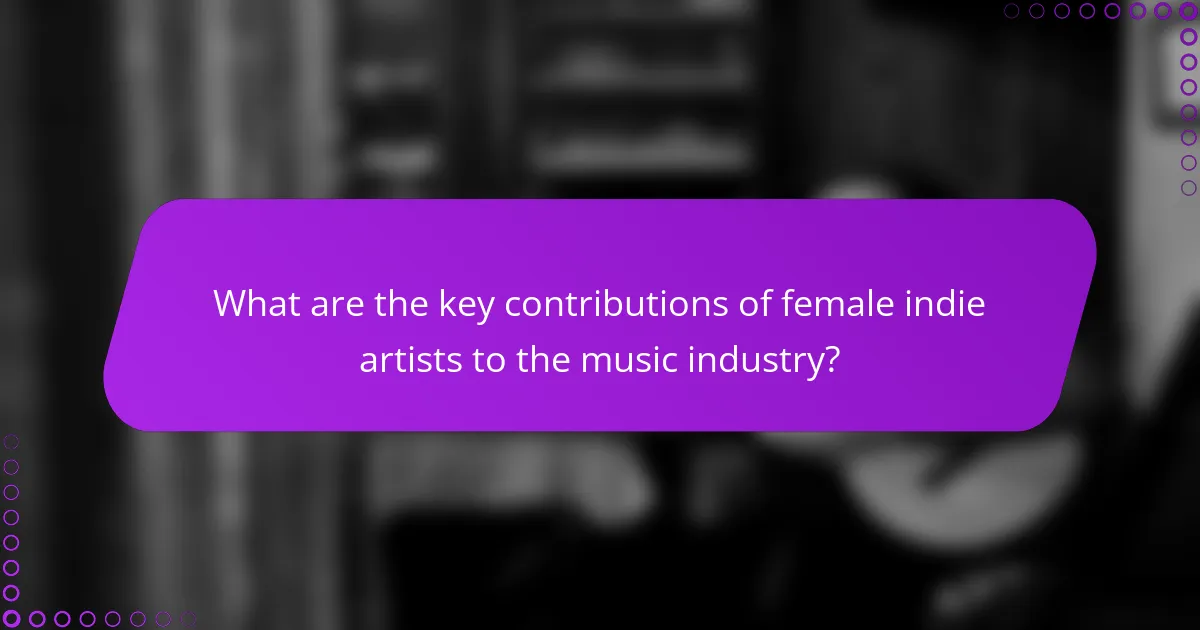
What are the key contributions of female indie artists to the music industry?
Female indie artists significantly shape the music industry through innovation, diversity, and authentic storytelling. They challenge mainstream norms, bringing unique perspectives and sounds. Their contributions include expanding genre boundaries, fostering community, and inspiring future generations. Statistics show that female-led indie acts often achieve critical acclaim and cultivate dedicated fan bases, highlighting their impact.
How do female indie artists influence genre diversity?
Female indie artists significantly influence genre diversity by introducing unique sounds and perspectives. Their contributions challenge traditional norms and encourage experimentation. For instance, artists like Phoebe Bridgers and Mitski blend genres such as folk, rock, and pop, creating fresh musical landscapes. Their success stories inspire emerging artists and promote inclusivity within the industry. As a result, female indie artists play a crucial role in shaping the future of music by diversifying its genres.
Which platforms are most popular for female indie artists?
Social media platforms and music streaming services are most popular for female indie artists. These platforms provide essential exposure and engagement opportunities.
1. Instagram: Visual storytelling allows artists to connect with fans and showcase their work.
2. Spotify: Offers playlist placements that enhance discoverability and streaming numbers.
3. Bandcamp: Empowers artists to sell music directly and build a loyal fanbase.
4. YouTube: Serves as a platform for music videos and live performances, increasing visibility.
5. TikTok: Viral potential helps artists reach new audiences quickly through short-form content.
These platforms collectively support the growth and success of female indie artists in a competitive industry.
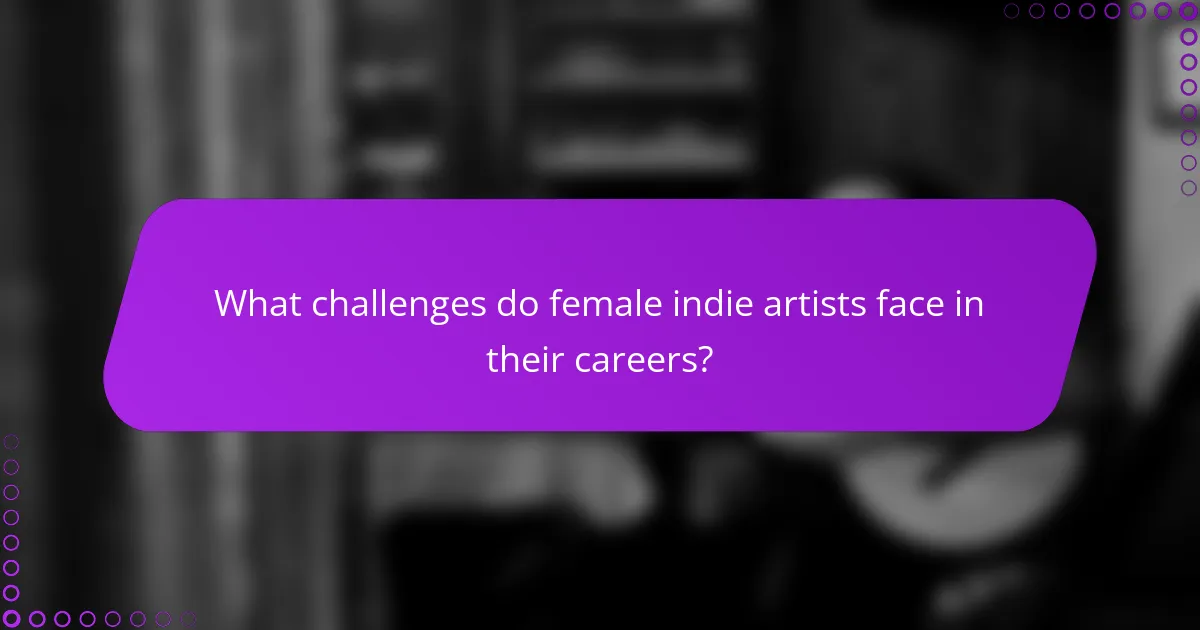
What challenges do female indie artists face in their careers?
Female indie artists face significant challenges including gender bias, financial instability, and lack of representation. These obstacles hinder their career growth and visibility in a male-dominated industry.
Gender bias manifests in fewer opportunities for performances and media coverage compared to male counterparts. Financial instability arises from limited access to funding and resources, making it difficult to promote their work. Additionally, the lack of representation in industry decision-making roles affects the support and recognition female artists receive.
As a result, many female indie artists must navigate these barriers while striving for success, often relying on grassroots efforts and community support to build their careers.
How does gender bias impact opportunities for female indie artists?
Gender bias significantly limits opportunities for female indie artists. This bias manifests through unequal access to funding, fewer performance slots, and less media coverage. Studies show that female artists often receive less support from industry gatekeepers compared to their male counterparts. As a result, many talented women face barriers that hinder their visibility and career advancement in the indie music scene.
What financial obstacles do female indie artists encounter?
Female indie artists encounter several financial obstacles, including limited access to funding, lower earnings from music sales, and high marketing costs. These challenges often hinder their ability to invest in production and promotion. Additionally, gender bias in the music industry can affect opportunities for sponsorships and grants, further complicating their financial landscape. As a result, many female indie artists struggle to achieve financial sustainability while pursuing their creative endeavors.
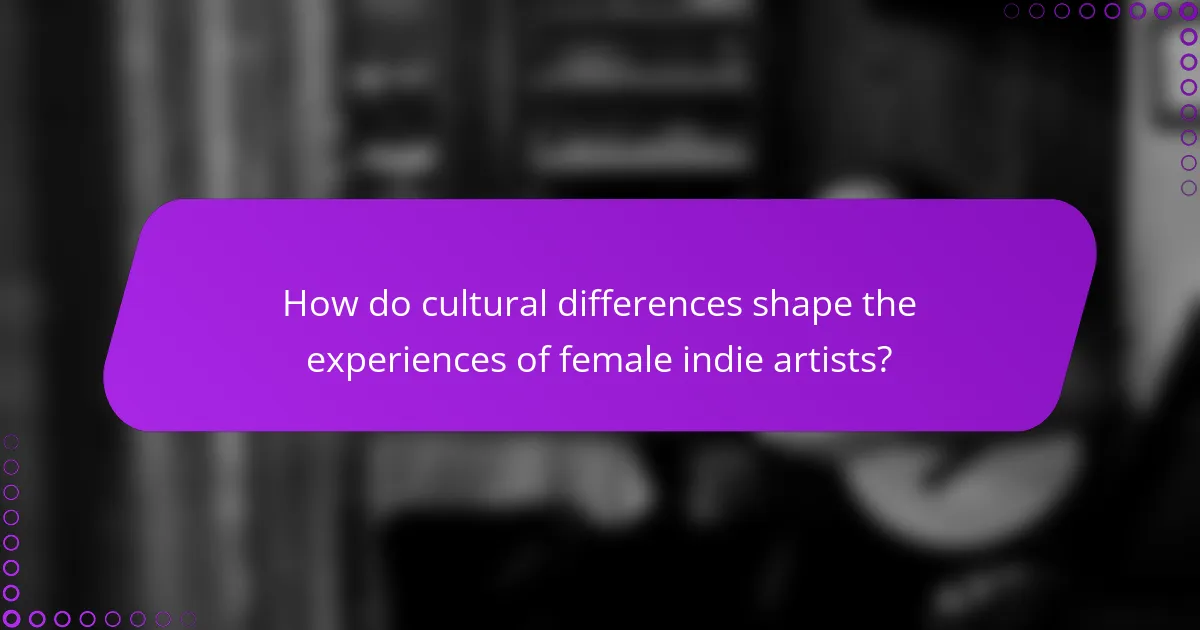
How do cultural differences shape the experiences of female indie artists?
Cultural differences significantly influence the experiences of female indie artists. These artists face varying levels of acceptance, support, and recognition based on their cultural backgrounds.
For example, in some cultures, female musicians may encounter traditional barriers that limit their opportunities. In contrast, other cultures may celebrate and promote female talent more actively.
Additionally, the themes in their music often reflect cultural narratives, which can resonate differently with audiences. This diversity enriches the indie music scene, showcasing unique stories and perspectives.
As a result, female indie artists navigate a complex landscape shaped by cultural expectations, ultimately impacting their artistic expression and career trajectories.
Which regions have the most supportive environments for female indie artists?
Regions with vibrant music scenes and strong community support are most conducive for female indie artists. Cities like Berlin, Nashville, and Toronto offer networking opportunities, funding, and inclusive spaces. Berlin is known for its diverse artistic community and affordable living, fostering creativity. Nashville, the heart of country music, provides mentorship and collaboration. Toronto boasts a thriving festival circuit and government grants, enhancing visibility for female artists. These environments empower female indie artists to thrive despite industry challenges.
How do language and cultural expression affect their music?
Language and cultural expression significantly shape the music of female indie artists. Their lyrics often reflect personal experiences, societal issues, and cultural heritage. This unique blend creates a distinct sound that resonates with diverse audiences. For instance, artists draw from their backgrounds to incorporate traditional elements, infusing their work with authenticity. As a result, their music becomes a powerful tool for storytelling and cultural representation, allowing them to address challenges like gender inequality and social justice.
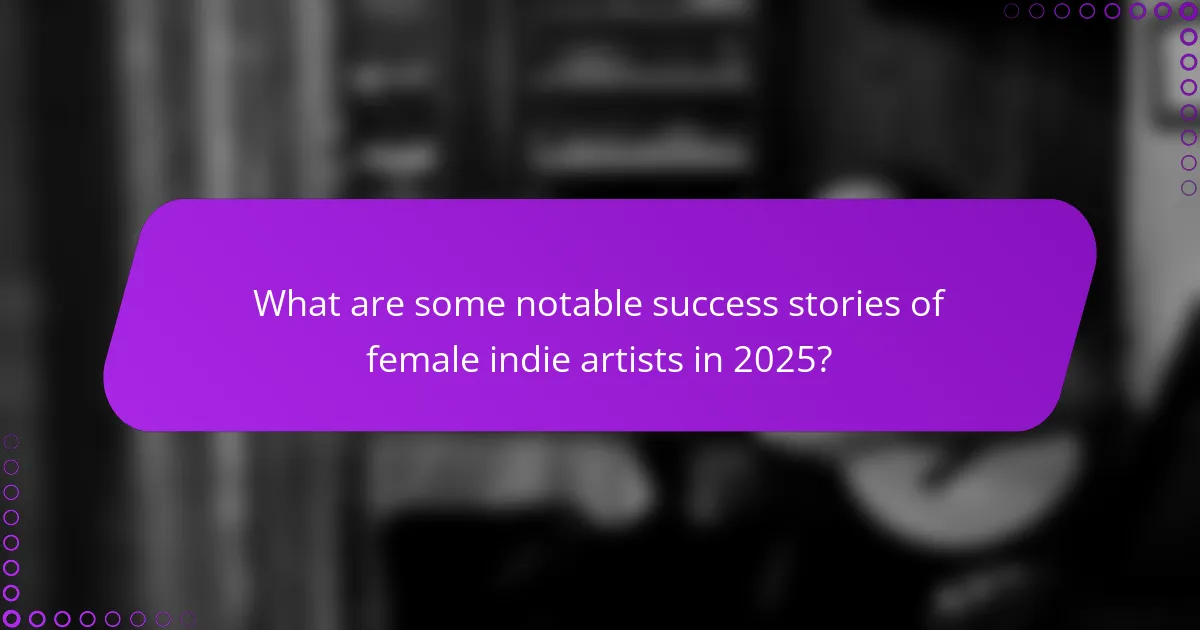
What are some notable success stories of female indie artists in 2025?
In 2025, notable success stories of female indie artists include artists like Billie Eilish, who continued to break records with her unique sound and powerful lyrics. Another example is Phoebe Bridgers, who gained recognition for her innovative collaborations and emotional storytelling. Additionally, artists like Mitski and Snail Mail have been praised for their distinct styles and impactful messages, resonating deeply with audiences. These artists exemplify the growing influence of women in the indie music scene, overcoming challenges and achieving significant milestones.
Which female indie artists have achieved international recognition?
Several female indie artists have achieved international recognition, including St. Vincent, Phoebe Bridgers, and Florence Welch. St. Vincent, known for her innovative sound, won a Grammy Award for Best Alternative Music Album. Phoebe Bridgers gained acclaim for her introspective lyrics and collaborations, while Florence Welch, as the frontwoman of Florence + The Machine, has captivated audiences worldwide with her powerful vocals and theatrical performances. These artists exemplify the growing influence of women in the indie music scene, overcoming challenges and reshaping the industry landscape.
What strategies did successful female indie artists use to build their brands?
Successful female indie artists often leverage social media, build community connections, and create authentic narratives to establish their brands. They utilize platforms like Instagram and TikTok for direct engagement with fans. Collaborations with other artists enhance visibility and foster supportive networks. Additionally, storytelling through their music and personal experiences resonates with audiences, creating a loyal fanbase. These strategies reflect their unique attributes, such as creativity and resilience, which differentiate them in a competitive industry.
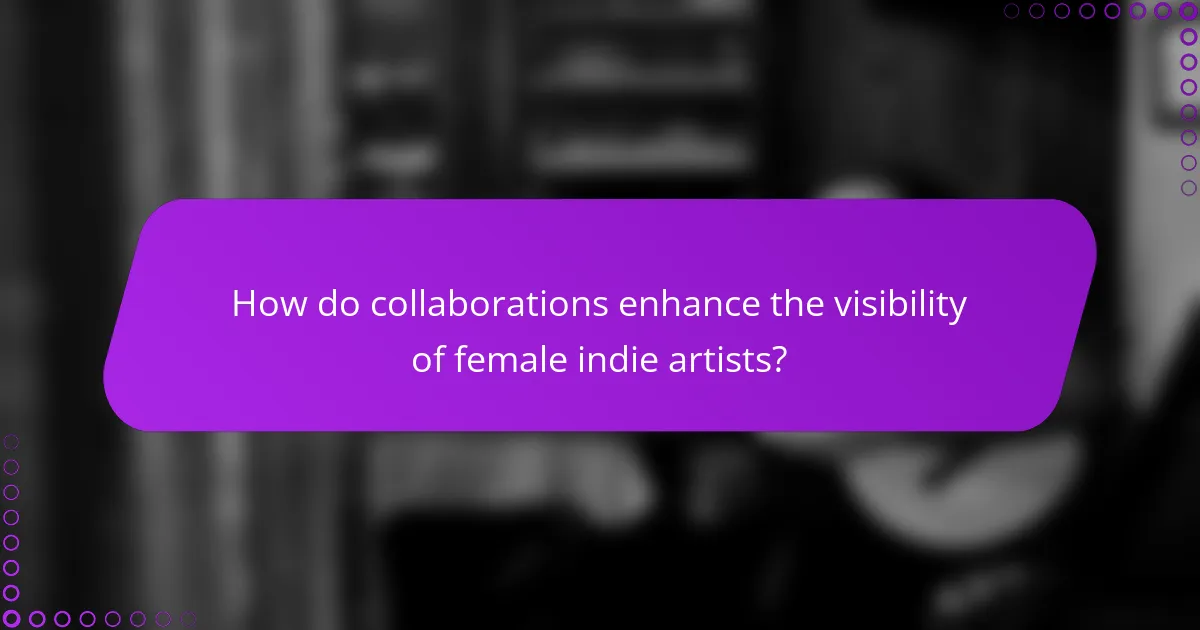
How do collaborations enhance the visibility of female indie artists?
Collaborations significantly enhance the visibility of female indie artists by expanding their reach and audience engagement. Partnering with other artists or brands allows for cross-promotion, which can introduce their music to new listeners. Collaborative projects often generate buzz and media attention, increasing exposure in both traditional and digital platforms.
Furthermore, collaborations can lead to unique soundscapes, attracting diverse fan bases and creating memorable experiences. For example, a female indie artist working with a popular producer may gain credibility and visibility in a competitive market. This synergy not only boosts individual careers but also fosters a supportive community among female artists, amplifying their collective voice.
What types of collaborations are most beneficial for female indie artists?
Collaborations that enhance visibility and creativity are most beneficial for female indie artists. Joint projects with other musicians, producers, or visual artists can create unique soundscapes and broaden audience reach. Networking with female-centric organizations fosters support and resource sharing. Collaborating on social media campaigns increases engagement and promotes messages of empowerment. Engaging in community events or festivals allows for live exposure and connection with fans. These partnerships can lead to innovative works and greater success in the indie music scene.
How can networking impact the careers of female indie artists?
Networking significantly enhances the careers of female indie artists by providing opportunities for collaboration, exposure, and mentorship. Through networking, these artists can connect with industry professionals, gain visibility, and access resources that may otherwise be unavailable.
Female indie artists often face unique challenges, such as gender bias and limited access to funding. Networking helps to mitigate these obstacles by fostering supportive communities. For example, participation in music festivals or online platforms allows artists to showcase their work and share experiences.
Statistics show that women in music who actively network report higher levels of career satisfaction and success. This highlights the importance of building relationships within the industry. As a result, networking becomes a vital strategy for navigating the competitive landscape of the music industry.
Success stories of female indie artists demonstrate the power of networking. Artists like Lizzo and H.E.R. have leveraged connections to amplify their careers, illustrating how networking can lead to significant opportunities and achievements.
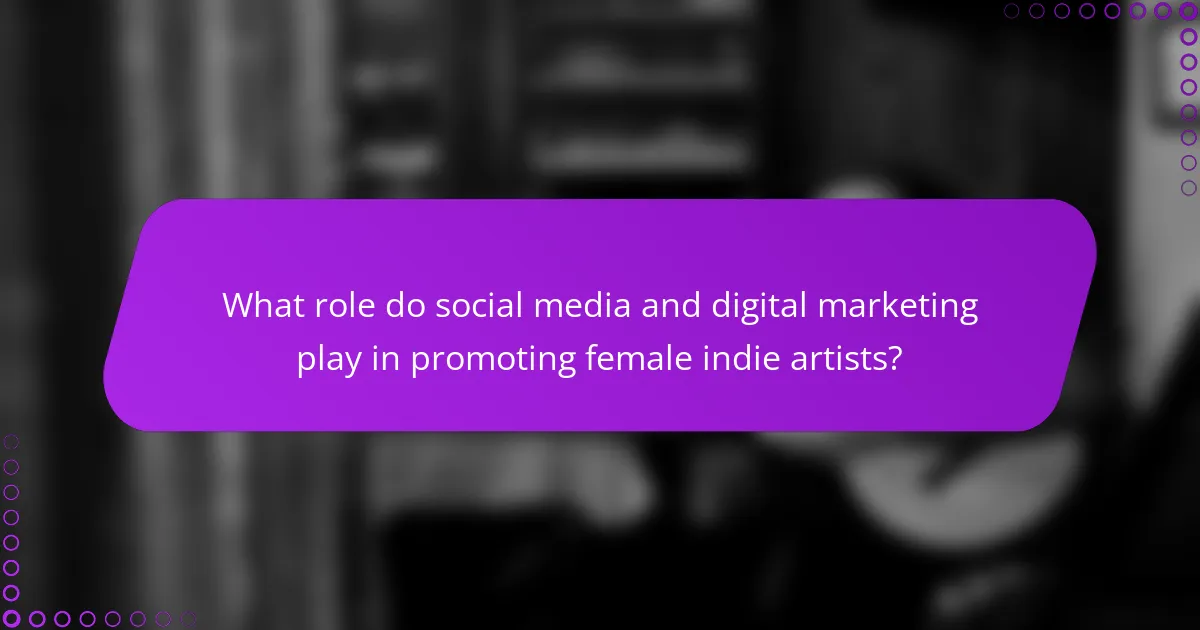
What role do social media and digital marketing play in promoting female indie artists?
Social media and digital marketing are crucial for promoting female indie artists by enhancing visibility and engagement. These platforms allow artists to connect directly with fans, share their music, and build a personal brand.
Social media enables real-time interaction, fostering a sense of community. For instance, platforms like Instagram and TikTok allow artists to showcase their creative processes and behind-the-scenes content. This unique engagement can lead to viral moments, amplifying their reach.
Digital marketing strategies, including targeted ads and email campaigns, help artists reach specific demographics. Data shows that 70% of music discovery happens through social media, highlighting its role in audience expansion.
Moreover, collaborations with influencers can elevate an artist’s profile. Female indie artists often leverage these partnerships to tap into established fan bases, creating new opportunities for exposure and success.
Which social media platforms are most effective for female indie artists?
Instagram, TikTok, and YouTube are the most effective social media platforms for female indie artists. These platforms enable artists to showcase their music, connect with fans, and build a community.
Instagram allows for visually engaging content and direct interaction with followers. TikTok’s short-form videos can create viral moments, increasing exposure rapidly. YouTube serves as a platform for longer performances and music videos, enhancing discoverability.
Data shows that 60% of indie artists find Instagram crucial for marketing, while 50% leverage TikTok for audience growth. YouTube remains vital, with 70% of artists using it to share music and behind-the-scenes content.
These platforms collectively contribute to the success of female indie artists by fostering creativity, engagement, and visibility in a competitive industry.
What are common pitfalls in digital marketing for female indie artists?
Female indie artists often face common pitfalls in digital marketing that hinder their success. These include lack of targeted audience engagement, inadequate social media strategy, inconsistent branding, and failure to utilize analytics effectively.
Many female indie artists struggle to identify and connect with their specific audience, leading to missed opportunities for growth. A strong social media presence is crucial; however, inconsistent posting or unclear messaging can dilute their impact.
Branding plays a significant role in recognition and loyalty. Without a cohesive brand identity, artists may fail to stand out in a crowded market. Additionally, neglecting to analyze marketing data can result in missed insights that inform better strategies.
Addressing these pitfalls can significantly enhance visibility and engagement, paving the way for greater success in the competitive landscape of the music industry.
What best practices should female indie artists follow for online promotion?
Female indie artists should leverage social media, engage with their audience, and collaborate with other musicians for effective online promotion. Building a strong personal brand and utilizing platforms like Instagram and TikTok can enhance visibility. Regularly sharing content, such as behind-the-scenes footage or live performances, fosters connection. Consistency in posting and interaction is key to maintaining audience interest and loyalty.
